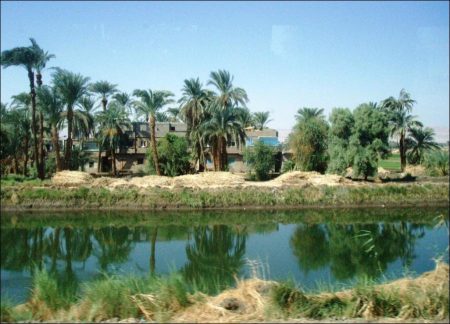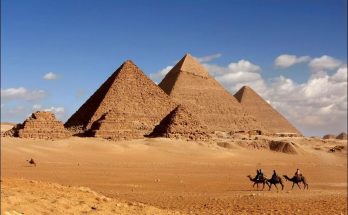For most of its 750-mile length from the Egypt-Sudan boundary to the head of the delta, about 10 miles north of Cairo, the shining snake of the half-mile wide Nile coils itself back and forth in a valley ten to twenty times its own breadth, though as wide as fourteen miles in some spots and as narrow as two hundred yards south of Aswan.
The river tends to hug the eastern edge of the valley floor, but it loops and meanders back and forth and narrow bands of cultivation are almost continuous on both aides. The level-floored groove of the Nile is enclosed by scarps rising as much as 1500 feet above the river, higher toward the Sudan, lower towards. Cairo; eastward and westward from the valley stretch great uninhabited plateaus.
To an airborne traveler, no contrast could be more vivid than that between the lifeless deserts and the green and fertile ribbon they enclose; “nowhere in the world is the contrast between the desert and the sown more dramatic, or the transition from solitary waste to teeming valley so sharp.” Within the valley every available square inch is irrigated and cultivated; the villages and other habitations (mostly fashioned of grey Nile mud) huddle along the useless desert fringe or perch on bits of high ground afforded by the natural levees beside the river.
Along the shore and in the villages stand useful date and doumpalms and a few isolated eucalyptus, sycamores, flamboyants, whispering tamarisks, acacias, broad-spreading mulberries, and a wide variety of fruit trees, which give color to the landscape and a modicum of protection from the rays of the sun, bearing down through a cloudless sky. The river itself is alive with traffic of every variety: small sailboats ferrying people from shore to shore or from village to village, larger craft and tugs and barges moving slowly upstream (with the wind) or floating their cargoes down to Cairo.
Physiographically the valley is divided into five sections, each characterized by certain distinctive features with respect to its borders, its width, and the nature and extent of its flood plain. From south to north these are: the Nubian valley south of Aswan, the Aswan-Isna section, the Isna-Nag’ Hammadi section, the Nile ravine between Nag’ Hammadi and Asyut, and the Asyut-Cairo section.
Visits: 168



